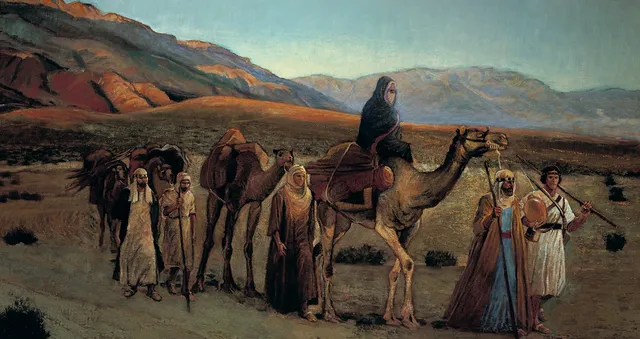
FAIR is a non-profit organization dedicated to providing well-documented answers to criticisms of the doctrine, practice, and history of The Church of Jesus Christ of Latter-day Saints.
“This family was living in a world of wickedness, but the Lord promised them that if they would follow Him, He would lead them to safety.”

“This family was living in a world of wickedness, but the Lord promised them that if they would follow Him, He would lead them to safety.”
FAIR Faithful Resources for Come, Follow Me 2024 January 8-14. 1 Nephi 1–5: “I Will Go and Do.” These trusted sources can help you find answers to difficult questions and help you in your learning and teaching.
Jump to section

The lesson points out that one prominent message in the Book of Mormon is the “great worth” of the word of God. As you consider the many ways Lehi’s family was blessed by the word of God, the following might be enlightening:
Many have questions about Nephi’s final, fatal interaction with Laban. Did Nephi commit “cold blooded murder” when he killed Laban? Could Satan have deceived Nephi into killing Laban? Find answers to these questions and more below.
Israelites from the Northern tribes, including the tribes of Joseph, had fled to Jerusalam in the 8th century BC
It is claimed that the fact that Lehi was not of Judah, but of the tribe of Joseph, makes it absurd for him to have been living in Jerusalem before the Babylonian captivity: “The tribe of Joseph at Jerusalem! Go, study scripture-geography, ye ignorant fellows, before you send out another imposition, and make no more such foolish blunders.”[1]
Research by Jeffery R. Chadwick shows that Israelites from the Northern tribes, including the tribes of Joseph, had fled to Jerusalam in the 8th century BC, and their descendants had become established in that city by the time of King Zedekiah.
The story of 1 Nephi begins in Jerusalem ca. 600 BC, where Lehi had “dwelt…all his days” (1 Nephi 1:4). A curious fact is that all our principal characters (Lehi, Laban, and Ishmael), as descendants of Joseph, are Israelites of the Northern Kingdom (see 1 Nephi 5:14, 16). Nonetheless, they seem to be wealthy and powerful people in Jerusalem. This would, at first, seem to be amiss, and certainly not what you would expect from a 19th century writer telling a story about “Jews at Jerusalem.” Archaeologist Jeffrey R. Chadwick, however, has shown that just a few generations earlier an influx of refugees from the Northern Kingdom poured into Jerusalem in the wake of the Assyrian conquest of 722-721 BC. These refugees had settled into an extension of the city known as the Mishneh, which by the time 1 Nephi begins, had become fairly well-to-do and had been enclosed by the extended city-wall. (See Jeffrey R. Chadwick, “Lehi’s House at Jerusalem and the Land of his Inheritance,” in Glimpses of Lehi’s Jerusalem, 87-99, 118-124.) This thus fits the portrayal in 1 Nephi of powerful and wealthy Northern Kingdom Israelites being present in Jerusalem at that period.
“The name of LMN [i.e., LaMaN, since Semitic languages at this point have no written vowels] is also found among the inscriptions”
Hugh Nibley noted:
The name of LMN [i.e., LaMaN, since Semitic languages at this point have no written vowels] is also found among the inscriptions. Thus in an inscription from Sinai: “Greetings Lamin, son of Abdal.” (Shlm Lminu bn Abdl).33 Recently the name Laman (written definitely with a second “a”) has turned up in south Arabia and been hailed by the discoverers as “a new name.”34 In an inscription reading “Lamai son of Nafiah erected this monument,”35 the final Yod is defective and suggests that the word is really Laman. In Palestine the name of Laman is attributed to an ancient Mukam or sacred place. Most of these Mukams are of unknown date, many of them prehistoric. In Israel only the tribe of Manasseh (Lehi’s tribe) built them.36 The name of Lemuel, as we have seen, also comes from the deserts of the south.[1]
Pendant names
Even more impressive is the issue of pendant names–names that go together, like “Mike and Ike” or “Ken and Barbie”.
Nibley points out:
But the most striking thing about the names of Laman and Lemuel is the way they go together; as we saw above it has been suggested that the former is but a corruption of the latter.37 Whether that is so or not, the musical pair certainly belong together and are a beautiful illustration of the old desert custom of naming the first two sons in a family with rhyming twin names, “a pair of pendant names,” as Spiegel puts it, “like Eldad and Medad, Hillek and Billek, or Jannes and Jambres. The Arabs particularly seem to enjoy putting together such assonant names Yāǵuǵ and Maǵūǵ for Gog and Magog, HārÅ«n and KārÅ«n for Aaron and Korah, HābÄ«l and KābÄ«l for Abel and Cain, ḪillÄ«t and MillÄ«t for the first dwellers in hell.”38 Speigel is here discussing the names Heyya and Abeyya, and might well have included in his parallels the recently discovered romance of Sul and Shummul. Harut and Marut were the first two angels to fall from grace, like Laman and Lemuel, according to Arab tradition of great antiquity. These names never go in threes or fours but only in pairs, designating just the first two sons of a family with no reference to the rest. This “Dioscuric” practice has a ritual significance which has been discussed by Rendel Harris, 39 but of the actual practice itself, especially among the desert people, there can be no doubt, for we read in an ancient inscription: “N. built this tomb for his sons Hatibat and Hamilat.”40 One could not ask for a better illustration of this little-known and, until recently, unsuspected practice than we find in the Book of Mormon where Lehi names his first two sons Laman and Lemuel.[2]
The existence of so many Hebrew and Egyptian names and phrases in the Book of Mormon is strong evidence of its truthfulness. Learn about these discoveries below.
The existence of so many Hebrew and Egyptian names and phrases in the Book of Mormon is strong evidence of its truthfulness. Learn about these discoveries below.

1-3: Nephi introduces himself and the record he is writing.
4-6: Lehi’s first vision is described, given as he prays for those in Jerusalem facing destruction.
7-15: Lehi’s second vision inwhich he sees the Savior. Though he sees the destruction of Jerusalem, he praises God.
16-20: Lehi again warns the inhabitants of Jerusalem to no avail. Nephi again describes the purpose of his record, part of which is to make clear the tender mercies of the Lord.
1-7: Lehi is warned, so packs his family and some of his possessions and travels into the wilderness.
8-15: We are introduced to Laman and Lemuel’s complaining natures. Lehi tries to comfort them through preaching and metaphor.
16-24: Nephi desires to also hear the voice of the Lord and prays mightily. He is blessed for his faithfulness and glimpses future possibilities for his immediate family and posterity.
1-9: Lehi sends his sons back to Jerusalem for the brass plates of Laban. Though Laman and Lemuel go very reluctantly, Nephi know that the Lord will prepare the way for their success.
10-14: Laman’s first attempt to get the plates is unsuccessful. He and Lemuel are ready to give up.
15-21: Nephi reinforces the importance of their mission and convinces the brothers to make another attempt.
22-27: The brothers gather their riches from their home and attempt to “purchase” the plates. Laban lusts after their wealth and attempts to kill them. They flee to the outskirts of the city.
28-31: In their anger, Laman and Lemuel beat and chastise Nephi and Sam. An angel intervenes and promises that their mission will be a success.
1-5: Using scripture, Nephi convinces Laman and Lemuel that the Lord will help them accomplish their task of obtaining Laban’s records. They return to Jerusalem.
6-18: Nephi finds Laban in a drunken state, and is constrained by the Spirit to kill him. Nephi is very hesitant, but eventually kills Laban.
19-27: Nephi, disguised as Laban, tricks Zoram into getting the plates and bringing them to the outskirts of the city.
28-38: Nephi, having obtained the records, is reunited with his brothers. Zoram is persuaded to leave Jerusalem and join them in their journey to a promised land.
1-9: Lehi and Sariah rejoice in the safe return of their sons with the plates. Lehi and Sariah’s faith in God is strengthened by their sons’ success. Sariah, in particular, had experienced fear and doubts during their long absence.
10-16: The contents of the brass plates are described. They contained scripture, history and genealogies.
17-22: Lehi prophecies of the great impact that the plates will have for his family on their journey.


After attending a large annual conference in Salt Lake City, and, having a good deal of business to attend to, I was somewhat weary, and at the close of the conference I thought I would retire to my home and have a rest.Wilford Woodruff followed the promptings of the Holy Spirit, not knowing the reasons for the direction he was given. Through his choices, he was saying, “I will go and do.” Like Nephi, Wilford and his family were blessed immensely for his obedience to the promptings of the Holy Spirit.
As I went into the yard the Spirit said to me, “Take your team and go to the farm,” which is some three miles south of the tabernacle.
As I was hitching the horses to the wagon Mrs. Woodruff asked where I was going. I said, “To the farm.”
“What for?” she asked.
“I do not know,” I replied; but when I arrived there I found out.
The creek had overflowed, broken through my ditch, surrounded my home and filled my barn-yard and pig pen. . . .
Through my own exertions I soon turned it, and prevented much damage that might have occurred had I not obeyed the voice of the Spirit.2
Endnotes
1 Discourse by Wilford Woodruff, July 3, 1880, p. 2, The Wilford Woodruff Papers, wilfordwoodruffpapers.org/discourse/1880-07-03.
2 Leaves from My Journal, p. 101, The Wilford Woodruff Papers, wilfordwoodruffpapers.org/autobiography/leaves-from-my-journal.

Kristi Favro
Kristi recently joined the Wilford Woodruff Papers Foundation as the Chief Operating Officer and feels privileged to be a part of this meaningful project to make Wilford’s records universally accessible. She and her husband live in Southern California and are blessed to have a blended family with eight amazing children.

Lesson devotionals are provided by the Wilford Woodruff Papers Foundation. Its mission is to digitally preserve and publish Wilford Woodruff’s eyewitness account of the Restoration of the gospel of Jesus Christ from 1833 to 1898. It seeks to make Wilford Woodruff’s records universally accessible to inspire all people, especially the rising generation, to study and to increase their faith in Jesus Christ. See wilfordwoodruffpapers.org.

FAIR is a non-profit organization dedicated to providing well-documented answers to criticisms of the doctrine, practice, and history of The Church of Jesus Christ of Latter-day Saints.
We are a volunteer organization. We invite you to give back.
Donate Now